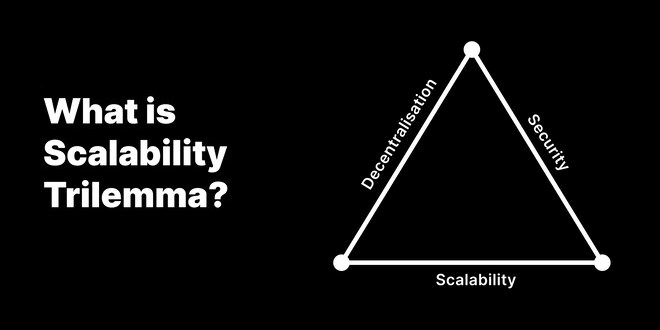In the respect of decentralization, scalability, and security, the Blockchain Trilemma implies a generally held notion that decentralized networks can only offer two of the three advantages at any given time. In this article, we will look into the idea of this matter, assessing all the most appropriate dimensions of the blockchain scalability trilemma.
The Blockchain Scalability Trilemma
The term “blockchain scalability trilemma” was invented by Vitalik Buterin. For blockchain scalability trilemma Vitalik explains it as an enigma that blockchain engineers encounter while balancing three opposing demands at once and that is security, decentralization, and scalability.
As per common conceptions, security, decentralization, and also scalability can only provide two among the three advantages that have been stated. The blockchain scalability trilemma may find a remedy once and for all thanks to a broad variety of Layer-1 and Layer-2 ventures. These potential answers have remained under development in the decentralized ecosystem for a long period of time.
- Security: Malicious actors, in this case, should be unable to take complete control of blockchain networks if strong defenses save them.
- Scalability: raising the number of transactions or even users on a blockchain should not outcome in increased costs or even longer transaction times.
- Decentralization: As opposed to a single owner, blockchains share network control with all their members.
With that now let us have a look at all the elements of the blockchain scalability trilemma for understanding this idea better.
Blockchain Scalability Trilemma: Security
There is a motivation to limit the pass of blockchain nodes either geographically, with respect to quantity, or both to increase network performance on a blockchain network. PoW networks are less safe because of this shift toward more centralization.
With few nodes in an open network, a 51 percent assault is more likely since hackers may assemble the required hashing power more effectively. Hackers can seize control of a network and they can alter transactions to make money.
The ETC (Ethereum Classic) network, which is a fork of Ethereum (ETH), went through three 51 percent assaults in August 2020, recreating more than 4,000 blocks, for instance.
As an outcome, the network lost millions of dollars in value because of manipulating data and duplicate spending of the ETC currency. The security of the blockchain is an important component of the network and it cannot be ignored.
Blockchain Scalability Trilemma: Scalability
It is evident to have high transactional throughput on any blockchain, but only if the blockchain can manage it in the long term. Because of this, the performance of the blockchain will not negatively react when more use scenarios and adoption take place.
Scalability implies the ability of a blockchain to manage increased usage. Blockchain scalability trilemma implies that scalability is conceivable, but decentralization or security will be compromised. At this stage, no blockchain network can fight with the network settlement and also usability of older, centralized systems.
Scaling stays a great difficulty for top decentralized networks today. Nevertheless, many blockchain exchanges have already created security and decentralization as core features.
Blockchain Scalability Trilemma: Decentralization
Blockchain operates on the notion of decentralization, which is at the center of many of the initiatives in the space. Dispensing with centralized bodies in all industries is possible by using decentralized technology and methods.
DeFi (Decentralized finance) platforms, rather than intermediaries, may share governance and profits with users and the bigger community by discarding banking institutions from financial items.
They are the basics of how the internet operates. That is the reason no single company has control over or censorship over the information flowing throughout decentralized networks. Boosting decentralization, on the contrary, tends to decrease network throughput. The speeds of transactions may slow as more miners create a Proof-of-Work (PoW) mechanism via consensus, which is witnessed as a barrier to mainstream adoption.
The Ethereum 2.0 And Polkadot Solutions
For initiatives such as Ethereum, which does not rely on another network, sharding has become a famous alternative. Another way, when any network “shards,” it divides the transactions of the blockchain into smaller bits. This way, the blockchain network can process more tractable data chunks more quicker.
As an outcome, the network could process added transactions at the same time without any delays. Also, the primary chain shards communicate and submit data to the blockchain platform to keep data safe.
An off-chain (verified) proof of the rollup attains the primary Ethereum blockchain trilemma, which processes the rollup and returns it to the primary chain. It is a lot similar to riding with a friend in a car. Because of their ability to reduce the amount of data needed for a transaction, rollups are effective.
Polkadot favors the notion of various blockchains working together rather than a one-blockchain result (interoperability). A “relay chain” caters as the backbone of the network, enabling for a highly scalable network. As separate chains that connect to the primary relay chain, parachains are utilized. Hence, the chains are able to evolve independently, but the platform as a whole is safer because of it.
Wrapping Up
Evolving blockchain scalability trilemma solutions may be able to dodge the blockchain trilemma, which provides substantial hindrances to blockchain adoption. Network security, scalability, and decentralization must all go through a hard optimization process. Considering the significance of this issue, it is not astonishing that so many teams of experts have devoted themselves to it.
The aim of the blockchain scalability trilemma is to find an efficient balance between network security, scalability, and decentralization. While the CAP theorem has held effective for almost four decades, the execution of Layer-1 and Layer-2 solutions, alongside the emergence of the PoS mechanism, is shifting the paradigm toward decentralized blockchain networks that are at once secure, distributed, and scalable. There are several trilemmas that include the Solana blockchain trilemma, Bitcoin trilemma, and Cardano blockchain trilemma.
 Crypto Venture News One stop Crypto Track Down
Crypto Venture News One stop Crypto Track Down 






